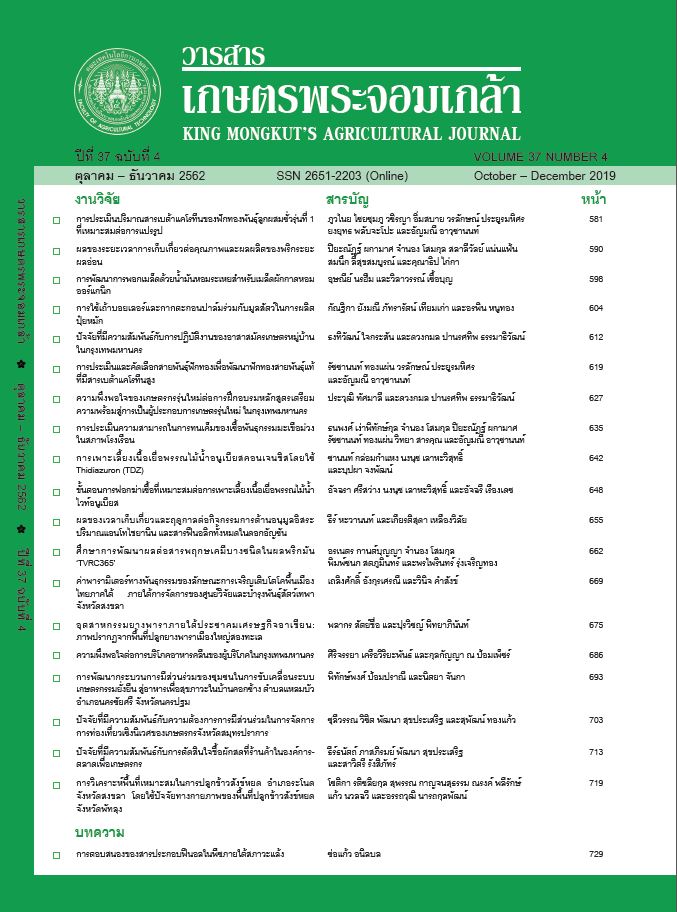ศึกษาการพัฒนาผลต่อสารพฤกษเคมีบางชนิดในผลพริกมัน ‘TVRC365’
Main Article Content
บทคัดย่อ
ศึกษาการพัฒนาผลของพริกต่อปริมาณพฤกษเคมีบางประการในผลพริกมัน ‘TVRC365’ เนื่องจากปัจจุบันมีผู้นิยมบริโภคทั้งในระยะผลเขียวและผลแดง ดังนั้นการทดลองครั้งนี้จึงมีวัตถุประสงค์เพื่อศึกษาการพัฒนาผลในแต่ระยะต่อปริมาณ
พฤกษเคมี โดยการปลูกพริกมันในกระถาง 12 นิ้ว ทำการผูกดอกในวันที่ดอกบาน และเก็บเกี่ยวผลพริกที่อายุ 7, 10, 14, 21, 28, 35, 42, 49 และ 53 วันหลังดอกบาน บันทึกข้อมูลการเจริญเติบโตของผล เช่น น้ำหนักสด ความยาว ความกว้าง ความหนาเนื้อ ความแน่นเนื้อ และวิเคราะห์ปริมาณสารพฤกษเคมี คือ คลอโรฟิลล์ เบต้าแคโรทีน ไลโคปีน วิตามินซี สารประกอบฟีนอล และฤทธิ์การต้านออกซิเดชันร้อยละ 50 (EC50) พบว่า การเจริญเติบโตของผลพริกมันเพิ่มมากขึ้น มีน้ำหนัก ความยาว ความกว้าง ความหนาเนื้อ และความแน่นเนื้อที่เพิ่มขึ้น ตามอายุผลจนถึง 42 วันหลังดอกบาน โดยที่ผลอายุ 49 วันหลังดอกบานเป็น
ระยะบริบูรณ์ที่มีการเจริญเติบโตสูงสุด รวมถึงมีการเปลี่ยนสีผลจากสีเขียวเป็นสีแดง นอกจากนี้เมื่อพิจารณาปริมาณพฤกษเคมีในช่วงการพัฒนาของผล พบว่าเมื่อผลอายุ 42 วันหลังดอกบานมีปริมาณคลอโรฟิลล์สูงและลดลงเมื่อผลอายุรวม 49 วัน
หลังดอกบาน แต่ผกผันกับปริมาณเบต้าแคโรทีนและไลโคปีนที่เพิ่มขึ้นที่ 49 วันหลังดอกบาน ส่วนสารประกอบฟีนอลและ EC50 มีแนวโน้มเพิ่มขึ้นและสูงที่สุดเมื่อผลอายุ 49 วันหลังดอกบาน
Article Details
วารสารเกษตรพระจอมเกล้า
เอกสารอ้างอิง
ใน มสธ. วิจัย ประจำปี 2554. น. 405-416. กรุงเทพฯ: มหาวิทยาลัยสุโขทัยธรรมาธิราช.
ไชยรัตน์ ส้มฉุน. 2558. บางช้าง TVRC365 ฟื้นพริกในตำนานสมัย ร 2. ไทยรัฐออนไลน์. http://www.thairath.co.th/content/ 506522,15.
(มีนาคม 2561).
พงษ์ศักดิ์ มานสุริวงศ์, วัลลภ สันติประชา และขวัญจิตร สันติประชา. 2554. การพัฒนาของสีผล เมล็ดและการสุกแก่ต่อคุณภาพเมล็ดพันธุ์พริกขี้หนูสวน. วารสารเกษตรพระจอมเกล้า 29(1): 26-35.
วีระ ภาคอุทัย และเยาวรัตน์ ศรีวรานนท์. 2557. พริก ปลูกอย่างไรในภาวะโลกกำลังร้อน. กรุงเทพฯ: สำนักงานกองทุนสนับสนุนการวิจัย.
Abdul Rahim, R. and I. Mat. 2012. Phytochemical contents of Capsicum frutescens (chili padi), Capsicum annuum (chili pepper) and Capsicum annuum (bell peper) aqueous extracts. IPCBEE. 40: 164-167.
Alama, A., Syazwaniea, N.F., Mahmoda, N.H., Badaluddina, N.A., ‘Ain Mustafab, K., Aliasa, N., Aslanic, F., and M. Asaduzzaman Prodhan. 2018. Evaluation of antioxidant compounds, antioxidant activities and capsaicinoid compounds of chili (Capsicum sp.) germplasms available in Malaysia. JARMAP. 1-9.
Arnon, D.I. 1949. Copper enzyme in isolated chloroplast, polyphenoloxidase in Beta vulgaris. Plant Physiol. 24: 1-15.
Bae, H., Jayaprakasha, G.K., Crosby, K., Yoo, K.S., Leskovar, D.I., Jifon, J. and B.S. Patil. 2014. Ascorbic acid, capsaicinoid, and flavonoid aglycone concentrations as a function of fruit maturity stage in greenhouse-grown peppers. J. Food Composition and Analysis 33: 195-202.
Brand-Williams, W., Cuvelier, M.E., and C. Berset. 1995. Use of a free radical method to evaluate antioxidant activity.
LWT Food Sci. Technol. 28 (1): 25-30.
Grubben, G.J.H. 1977. Tropical vegetables and their genetic resources. Rome: International Board for Plant Genetic Resources.
Ha, S-H., Kim, J-B., Park, J-S., Lee, S-W., and K-J. Cho. 2007. A comparison of the carotenoid accumulation in Capsicum varieties that show different ripening colours: deletion of the capsanthin-capsorubin synthase gene is not a prerequisite for the formation of a yellow pepper. J. Exp. Bot. 58(12): 3135-3144.
Li, H., C. Tang, Z. Xu, X. Liu and X. Han. 2012. Effects of different light sources on the growth of non-heading Chinese cabbage (Bressica campestris L.). J. Agric. Sci. 4(4): 262-273.
Matsufuji, H., Ishikawa, K., Nunomura, O., Chino, M., and M. Takeda. 2007. Anti-oxidant content of different coloured sweet peppers, white, green, yellow, orange and red (Capsicum annuum L.). JFST. 42: 1482-1488.
Molyneux, P. 2004. The use of the free radical diphenylpicrylhydrazyl (DPPH) for estimating antioxidant activity. Songklanakarin Journal of Science and Technology 25: 211-219.
Nagata, M. and I. Yamashita. 1992. Simple method for simultaneous determination of chlorophyll and carotenoids in tomato fruit.
J. Japan. Soc. Food Sci. Technol. 39(10): 925-928.
Poulos, J.M. 1993. Pepper Breading. In Breading of solanaceous and cole crops. Chadha M.L, A.K.M. Amzad Hossain and M.Hossain (eds). pp. 85-121. Tainan: The World Vegetable Center.
Saidu, A.N. and R. Garba. 2011. Antioxidant activity and phytochemical screening of five species of capsicum fruits. IRJBB.
1(9): 237-241.
Sbrussi, C.A.G., Zucareli, C., Prando, A.M., Almeida, B.V., and B. Silva. 2014. Maturation stages of fruit development and physiological seed quality in Physalis peruviana. Rev. Ciênc. Agron. 45(3): 543-549.
Singleton, V.L., Orthofer, R. and R.M. Lamuela-Ravenros. 1999. Analysis of total phenols and other oxidation substrates and antioxidants by means of folin-ciocalteu reagent. Methods Enzymol. 299: 152-178.
Vera-Guzmán, A.M., Chávez-Servia, J.L., Carrillo-Rodríguez, J.C., and M.G. López. 2011. Phytochemical evaluation of wild and cultivated pepper (Capsicum annuum L. and C. pubescens Ruiz & Pav.) from Oaxaca, Mexico. JAR. 71(4): 578-585.
Zhang, D. and Y. Hamauzu. 2003. Phenolic compounds, ascorbic acid, carotenoids and antioxidant properties of green, red and yellow bell peppers. JFAE. 1(2): 22-27.


